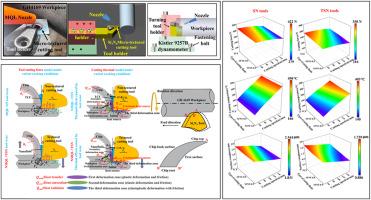Combining micro-textures and nanofluid electroosmotic flow for improving wear resistance of Si3N4 ceramic tools in machining of nickel-based superalloys
IF 6.6
2区 材料科学
Q1 MATERIALS SCIENCE, MULTIDISCIPLINARY
Journal of Materials Research and Technology-Jmr&t
Pub Date : 2025-09-19
DOI:10.1016/j.jmrt.2025.09.174
引用次数: 0
Abstract
To address the challenge of insufficient penetration performance of cutting fluids at the tool-chip interface in Si3N4 ceramic tool machining of nickel-based superalloys, which leads to inadequate cooling/lubrication efficiency and consequently rapid tool wear and machining damage, this study proposes a novel cooling/lubrication method combining micro-textured tools with nanofluid electroosmotic flow under self-excited electric field assistance. This approach enhances efficient nanofluid penetration and lubrication at the micro-textured Si3N4 tool-chip interface. Initially, numerical simulations were conducted to analyze the flow and heat transfer characteristics of nanofluids in micro-textured channels under self-excited electric fields. A comprehensive electroosmotic flow and heat transfer model was established based on principles of electrostatics, thermodynamics, and fluid dynamics. The results demonstrated that increased electric field intensity enhanced both the electroosmotic force and flow velocity of nanofluids within micro-textured channels. Subsequent cutting experiments on GH4169 nickel-based superalloy investigated the effects of nanofluids with distinct electrical properties on the cutting performance of Si3N4 ceramic tools under self-induced electric fields. Experimental data revealed that the textured Si3N4 tools (TSN) lubricated with SiO2 nanofluid (SSNF) exhibited optimal cutting performance. At a cutting speed of 157.1 m/min, compared to the non-textured Si3N4 tool (SN) lubricated with traditional cutting fluid (TCF) and TSN tool lubricated with Fe3O4 nanofluid (SFNF), the cutting force was reduced by 32.71 % and 15.66 %, respectively, while cutting temperature decreased by 30.61 % (equivalent to a reduction of 150 °C) and 9.10 % (equivalent to a reduction of 34 °C). Additionally, surface roughness was reduced by 56.52 % and 15.79 %.

结合微织构和纳米流体电渗透提高氮化硅陶瓷刀具加工镍基高温合金的耐磨性
针对Si3N4陶瓷刀具加工镍基高温合金时,切削液在刀屑界面的渗透性能不足,导致刀具的冷却/润滑效率不足,从而导致刀具的快速磨损和加工损伤的挑战,本研究提出了一种自激电场辅助下微织化刀具与纳米流体电渗透相结合的新型冷却/润滑方法。这种方法增强了纳米流体在Si3N4微晶化工具-芯片界面的高效渗透和润滑。首先,通过数值模拟分析了自激电场作用下纳米流体在微纹理通道中的流动和换热特性。基于静电学、热力学和流体动力学原理,建立了一个综合的电渗透流动和传热模型。结果表明,电场强度的增加可以增强微结构通道内纳米流体的电渗透力和流速。随后对GH4169镍基高温合金进行了切削实验,研究了具有不同电学性质的纳米流体在自感电场下对Si3N4陶瓷刀具切削性能的影响。实验数据表明,sio_2纳米流体(SSNF)润滑的Si3N4织构刀具(TSN)具有最佳的切削性能。在157.1 m/min的切削速度下,与传统切削液(TCF)润滑的非织构化氮化硅刀具(SN)和纳米Fe3O4润滑的TSN刀具(SFNF)相比,切削力分别降低了32.71%和15.66%,切削温度分别降低了30.61%(相当于降低150℃)和9.10%(相当于降低34℃)。表面粗糙度分别降低了56.52%和15.79%。
本文章由计算机程序翻译,如有差异,请以英文原文为准。
求助全文
约1分钟内获得全文
求助全文
来源期刊

Journal of Materials Research and Technology-Jmr&t
Materials Science-Metals and Alloys
CiteScore
8.80
自引率
9.40%
发文量
1877
审稿时长
35 days
期刊介绍:
The Journal of Materials Research and Technology is a publication of ABM - Brazilian Metallurgical, Materials and Mining Association - and publishes four issues per year also with a free version online (www.jmrt.com.br). The journal provides an international medium for the publication of theoretical and experimental studies related to Metallurgy, Materials and Minerals research and technology. Appropriate submissions to the Journal of Materials Research and Technology should include scientific and/or engineering factors which affect processes and products in the Metallurgy, Materials and Mining areas.
 求助内容:
求助内容: 应助结果提醒方式:
应助结果提醒方式:


